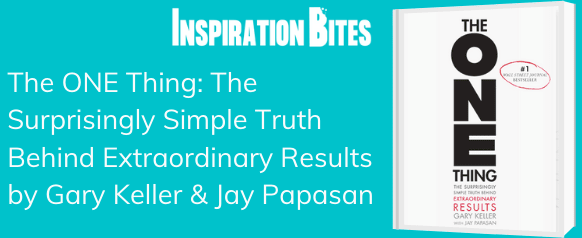

If allowed, they set our priorities the same way an inbox can dictate our day. Which is why most of us have a love-hate relationship with our to-dos. While to-dos serve as a useful collection of our best intentions, they also tyrannise us with trivial (and important) stuff that we feel obligated to do. Achievers always work from a clear sense of priority. Success isn't a game won by whoever does the most. Activity is often unrelated to productivity, and busyness rarely takes care of business. Keller closes the book with a set of guiding questions to help readers apply his advice to all levels of their life, including their personal life, family, job, and work team.In the world of achievement equality is a lie. He urges readers to live with purpose and to focus on that purpose so that they can live lives celebrating what they have accomplished rather than regretting what they have not done. In Chapter 18, Keller summarizes the principles of The ONE Thing. Keller provides advice for overcoming each of these obstacles. Conversely, Chapter 17 discusses four “thieves” that can hinder pursuit of your purpose: an inability to say “no,” fear of chaos, neglect of health, and unsupportive environments. Keller introduces additional principles in Chapter 16 that can help readers on their journey, including mastery as a path instead of a destination, a purposeful rather than entrepreneurial mindset, and accountability. Chapter 13 meditates further on the idea of purpose, while Chapters 14 and 15 delve deeper into the concepts of purpose and productivity. This final section of the book also considers how Keller’s principles apply beyond the business world. Part 3, “Extraordinary Results,” provides further details and advice to help readers become more productive, set better goals, and realize their purpose. Chapter 12 goes into greater detail about what constitutes a “Great Question” or “Great Answer.” Keller encourages readers to seek goals that will push them beyond what they think they can do in order to achieve real success and move toward their purpose.
#The one thing summary how to#
The Focusing Question provides the essential formula for discovering the “ONE Thing,” and in Chapter 11, Keller describes how to turn the insights of this question into habits that drive success. Chapter 10 describes what Keller calls “The Focusing Question,” which asks readers to consider one thing they can do in pursuit of any task or goal to make all else easier or unnecessary. In Part 2 (“The Truth”), Keller lays out the basic principles for developing more purpose-driven goals and setting priorities more effectively. Keller closes Part 1 in by encouraging readers to think big in terms of their purpose and not to fear success. This is a good thing as long as you don’t forget the highest priorities (such as health and family). Chapter 9 rejects the idea of work-life balance, arguing that the pursuit of success will at times mean intentionally getting out of balance. Instead, he encourages them to take advantage of the times when their willpower is at its peak (such as early morning) by devoting those times to the highest-priority tasks. Willpower is the subject of Chapter 7, with Keller recommending that readers avoid thinking they can summon willpower at any time and for any need. In Chapter 6, Keller contrasts the concept of discipline with the idea of building habits and insists that developing positive habits and training oneself is key. He states that this is additional evidence for the power of focusing and prioritizing. Chapter 5 critiques multitasking, with Keller drawing on research that shows it can harm energy and attention. Keller cites the “80/20 Principle,” which states that 80% of success comes from 20% of effort, to argue that there is value in devoting attention to the most impactful tasks and goals.

Chapter 4 contends that believing all things are equal is a mistake. Part 1 of The ONE Thing (“The Lies”) then examines myths and misconceptions that surround traditional characterizations of success. Chapter 3 reviews examples of businesses and individuals that Keller views as successful, showing that all of them have benefited from focus and the help of mentors.


In Chapter 2, Keller uses the metaphor of dominoes falling in succession to illustrate how tasks undertaken in the pursuit of a goal are most effective when they are incremental and cumulative, with a view to long-term purpose. Focusing in this way, Keller advises, ensures that goals are best aligned with purpose and prioritized in such a way that you can achieve them. Chapter 1 outlines Keller’s idea of the “ONE Thing,” which means focusing on the most important task or concern of a given goal. Keller divides The ONE Thing into three major parts but prefaces these with three introductory chapters.


 0 kommentar(er)
0 kommentar(er)
